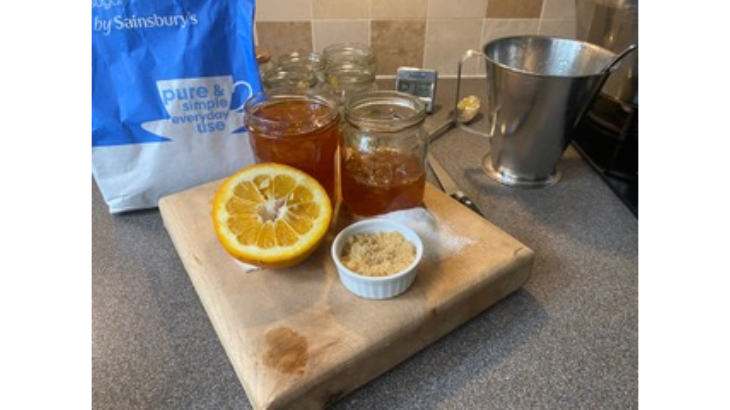Seville Orange Marmalade

One of the things I look forward to in January is replenishing our marmalade stock. Home-made marmalade is a true delicacy and bears no resemblance to even the very best shop-bought variety. Its flavour is distinctive and wakens up the taste buds in a way that nothing else can. Now is the marmalade season, as it is only in January and February that the Seville orange appears in the shops, so catch them while you can!
Don’t be daunted by the length of cooking time – it’s fine to boil the fruit up one day, leave it overnight and finish off the next day. At a pinch, you could boil up the fruit, extract the juice from the muslin bag and then freeze the resultant mix, to complete the job another day.
Ingredients
· 1.5kg or 3lbs Seville oranges
· 2 medium lemons
· 2kg granulated sugar
· Water
Essential equipment
· Large non-aluminium preserving pan
· Large bowl for the sliced peel
· Muslin bag
· If you have a sugar thermometer, it will make the process easier
Method
Squeeze the lemons and set juice aside to add later in the process.
Wash the oranges and remove and discard the stalk from each.
Halve the oranges and squeeze, then strain the juice. Put all the pips in the muslin bag.
Next use a dessert spoon to scoop out the pith from the oranges. Add it to the muslin bag, with the pips.
Tie the bag shut – you don’t want pips in the finished marmalade! (In the boiling process, pips and pith release pectin which, as well as making the marmalade set, add to home-made marmalade’s distinctive flavour.)
If you have a food processor with a marmalade slicer attachment, the next step is easy. If not, you will need a sharp knife and some “elbow grease”! Cut all the orange peel into reasonably fine shreds. You can add the lemon peel if you like.
Once all the peel is shredded, put it in the preserving pan, then tie the closed muslin bag to the pan’s handle, making sure it sits well in the fruit. Add approximately 4 pints of water and stir the mix around.
Bring the pan to the boil and then let it simmer for about 2 hours. Stir occasionally and top up the water if necessary. After about two hours, check the peel is softened to your liking, then remove pan from the heat.
Allow the mixture to cool sufficiently to remove the bag of pips and pith from the pan. Place the bag in a colander over a bowl to drain, then squeeze as much goo out as possible. Return the goo to the pan but discard the pith and pips which have now done their job.
Measure the contents of the pan into a large bowl. There will be 3 to 3.5 pints, but if there is not much liquid, you can add some at this point. Put everything back in the pan, adding the lemon juice at this stage.
Now double check the peel is soft enough for your taste, as the next stage is adding the sugar and once the sugar is added, the peel will no longer soften. The recommended quantity of sugar is 1lb to 1 pint of liquid. If you prefer a tart marmalade, use less sugar, more if you like a sweeter product. If you like dark marmalade, substitute a proportion of granulated sugar with demerara or dark brown sugar.
Slowly reheat the peel/juice/sugar mix, stirring carefully to prevent it “catching” on the base of the pan. You will feel the grittiness of undissolved sugar in the pan at first, so keep stirring as it’s important that all the sugar crystals dissolve before bringing the pan to the boil. Keep it on a fast boil for about 10 minutes, stirring it often to make sure it doesn’t catch on the base of the pan. Test at this point with a jam thermometer if available. Even after the temperature shows jam setting point, the marmalade needs to boil for a bit longer.
I recommend the following process to check whether it will set once it is jarred up: Chill a plate in the fridge, then put a spoonful of mix onto it and return to the fridge to cool for several minutes. Now test the set by literally pushing the edge of the sample. If it is cold and sufficiently set, it will visibly wrinkle. If this doesn’t happen, the mixture hasn’t set so boil for a few more minutes (still stirring gently), then repeat the test.
I make marmalade every year, and every year I find it takes longer than I expect to reach setting point. Recipe books describe the mix reaching a “roiling boil” and once you see this for yourself you will know what it looks like.
Now remove the pan from the heat and let it stand for about 15 minutes. Stir it again when it has cooled a little, then pot it. Although it’s annoying it isn’t a disaster if, once it has cooled, you find it hasn’t set sufficiently. You can still put it all back in the pan and boil it again.
The final challenge is waiting till it’s properly cooled before taking a slice of bread and butter and taking your first bite!
